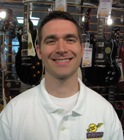Why You NEED to Know Barre Chords
|
By Ben BlakesleyGeorges Music
|
 |
You've mastered open chords. You can switch between them like lightning and they sound gorgeous!Then you decide to learn a new song and there it is...A giant Eb chord staring back at you from the page. You're stuck.Time to learn barre chords!! It's easier than you think and it will open up a world of possibilities for you. 64 chords in 2 simple steps!
The Barre
The most important part of the barre chord is (surprise, surprise) the barre. The barre part of the barre chord[caption id="attachment_357" align="alignright" width="300" caption="Fig 1"]

[/caption](also spelled bar chord) is simply your index finger laid across all the guitar strings at once. Think about this like moving the nut of the guitar up and down the neck (or using a capo). It changes the pitch of all the strings by the same amount all at once. [See fig 1]Practice strumming the guitar and placing your barre (your finger) at different frets up and down the neck. If you've never played barre chords before, it may take some practice to increase your finger strength to be able to do this comfortably.
E - Form
Now that you've mastered barring your finger across all the strings up and down the neck, let's turn that into a usable skill by making it a major chord. If you go back to thinking about your barre finger as the nut of the guitar, you can use your remaining 3 fingers to form what looks like an E major chord when you're in the first position on the guitar neck. [See fig 2][caption id="attachment_358" align="alignleft" width="300" caption="Fig 2"]

[/caption]If you put your barre finger in the first fret, then form your E chord, you'll be playing a major chord 1/2 step higher than E. It's an F chord! Congratulations, your first official barre chord!And it works that way all the way up the neck with each fret raising the pitch by 1/2 step. So if you place your barre finger in the 5th fret, you'll be playing A major, 6th fret Bb major, and so on.
A- Form
The other common barre chord type is the A chord form, also called a double barre. This is accomplished by placing your barre finger on the neck as in the previous form, then add your 3rd finger (ring finger) barring the 2nd, 3rd, and 4th strings two frets further up on the neck from your index finger. [See fig 3] Just like making an A major chord.So if you place your barre in the 5th fret, that's a D major chord, 6th fret is Eb major, and so on.[caption id="attachment_359" align="alignright" width="300" caption="Fig 3"]

[/caption]
Conclusion
As you can see, this opens up a world of opportunity to play any major chord without much thought. Once you get used to barring these two types of chords, start getting creative and think about what other chord shapes you could use with a barre (minor chords would be a good next step).
Ben Blakesley is in charge of Marketing and Technology at George's Music and accomplishes most of his guitar playing using just two fingers. Now you know how too.


 [/caption](also spelled bar chord) is simply your index finger laid across all the guitar strings at once. Think about this like moving the nut of the guitar up and down the neck (or using a capo). It changes the pitch of all the strings by the same amount all at once. [See fig 1]Practice strumming the guitar and placing your barre (your finger) at different frets up and down the neck. If you've never played barre chords before, it may take some practice to increase your finger strength to be able to do this comfortably.
[/caption](also spelled bar chord) is simply your index finger laid across all the guitar strings at once. Think about this like moving the nut of the guitar up and down the neck (or using a capo). It changes the pitch of all the strings by the same amount all at once. [See fig 1]Practice strumming the guitar and placing your barre (your finger) at different frets up and down the neck. If you've never played barre chords before, it may take some practice to increase your finger strength to be able to do this comfortably.
 [/caption]If you put your barre finger in the first fret, then form your E chord, you'll be playing a major chord 1/2 step higher than E. It's an F chord! Congratulations, your first official barre chord!And it works that way all the way up the neck with each fret raising the pitch by 1/2 step. So if you place your barre finger in the 5th fret, you'll be playing A major, 6th fret Bb major, and so on.
[/caption]If you put your barre finger in the first fret, then form your E chord, you'll be playing a major chord 1/2 step higher than E. It's an F chord! Congratulations, your first official barre chord!And it works that way all the way up the neck with each fret raising the pitch by 1/2 step. So if you place your barre finger in the 5th fret, you'll be playing A major, 6th fret Bb major, and so on.
 [/caption]
[/caption]